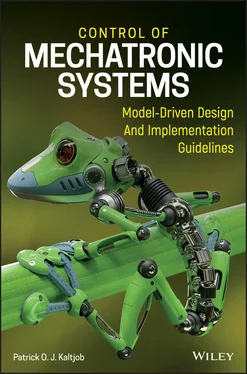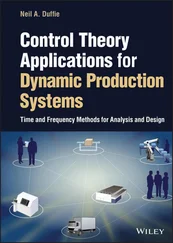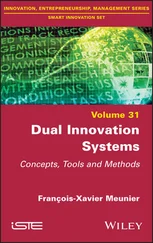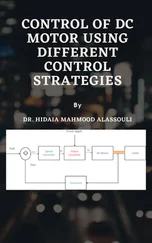10 1.10 Consider a control project upgrading a distributed control (no single point of failure) for an express parcel handling and dispatching center. Among the control design requirements are: (i) a parcel dimension check point; and (ii) parcel priority levels. All parcels pass through an integrated security system consisting of a series of security scanners while being directed automatically by barcode scanning points along long-distance conveyor system and a robot handling system at each end to their final transit destination via a temporary storage room.Identify the control objectives for this parcel handling and dispatching center.List key I/O variables (logic and continuous) for the handling and dispatching center.Sketch the block diagram of this system as well as an operator panel including all I/O system and control variables.
11 1.11 Similar to blood glucose level or blood pressure regulation, the regulation of human body blood temperature is performed through the evaporation of water from the skin over the capillary network.Identify the continuous and logic control objectives for blood temperature regulation in the human body.Sketch a hybrid control block diagram for the human body blood temperature continuous control problem.Integrate this system block diagram with one for human blood pressure regulation and one for human blood glucose level control.From the preceding block diagram, identify devices that could be used in the measuring and detecting unit and in the actuating unit of this multi-level automated human blood regulation process.
12 1.12 From the cake conveyor oven depicted in Figure 1.18, it is necessary to control temperature and air moisture within the oven chamber as well as the conveyor speed in order to ensure a suitable cake baking process. An image processing camera is used for thermal sensing configuration of the chamber and an operator panel is used to define configuration settings and display operating conditions.List key I/O (binary and continuous) control and system variables involved.Draw the hybrid control block diagram and operator panel with I/O controls and process variables. Figure 1.18 Cake conveyor oven.Source: Based on Kaltjob P.
13 1.13 Among vehicle-based mechatronic systems, there are:the antilock brake system (ABS) to allow vehicle wheels to smoothly stop their rotation when a mechanical brake is activated;the traction control system (TCS);the vehicle dynamics control (VDC):the electric spark ignition for fuel-air combustion;the engine management and transmission control;the airbag activation;the air conditioning system;seat belt control;mirror control;climate and vehicle front light activation control;the parking distance control system;parallel self-parking;the averaging fuel tank level;the alcohol test and engine activation;the window lift system.Based on either operating objectives such as comfort, safety, and emission reduction, or autonomous and intelligent cruise control objectives, classify the mechatronic systems listed here.For five mechatronic systems out of this list, define the possible I/O variables involved (hint: each variable is associated with a field control device).
14 1.14 Consider the horizontal motion of a helicopter hovering as depicted in Figure 1.19. The motion equipment includes an engine-driven rotor with a speed control while the pitch angle is given by the drivetrain. The wind speed can be considered a disturbance and its power is related to altitude height, also called the shear coefficient. Then, the helicopter's motion can be defined by the rotor and drivetrain. Sketch a block diagram for the speed and direction control from variations associated with the pitch rate, the pitch angle of the fuselage, and the rotor tilt angle. Figure 1.19 Helicopter schematic.Source: Based on Kaltjob P.
15 1.15 Consider a gold-mining extraction operation, as depicted in Figure 1.20. It is necessary to monitor and remotely control the primary and secondary crushing motors, raw material conveyor motors, ball milling (grinding), operations related to pressurized watering, underground soil feeding in transportation trailers during extraction operations, and operations related to leading and tailings stacking.List key I/O variables involved in the monitoring and control of a gold-mining extraction process.Sketch the corresponding control system block diagram including the monitoring and control system instruments as well as I/O variables involved. Figure 1.20 Electric-driven car moving up the hill.
16 1.16 Consider robot harvesting machines that perform autonomous fruit detection in trees, picking fruit from the foliage without damage. Then the fruit is transferred directly into mobile collecting boxes as depicted in Figure 1.21. Figure 1.21 Automatic fruit harvesting robot.Source: Based on Kaltjob P.Identify the major I/O (continuous and binary) variable systems and sketch the hybrid control block diagram with I/O variables of this harvesting robot integrating the following continuous and logic control functions:Fruit detection (fruit tree location) using 3D camera image processing (color uniformity, maturity recognition using near-infrared for sugar content, selection based on size and shape) and a laser ranging sensor.The path generation and motion planning (position, speed, and acceleration) for the harvesting robot's exploration using optical, magnetic, laser-guided, and GPS tools while ensuring that the robot manipulator avoids collisions.The logic control for activating a solenoid in charge of a vacuum suction nozzle, especially for mature but resistant-to-vibration fruit.The continuous control of the angular position of the robot picker arm fingers with interior foam sponge pads combined with a cutter for picking. The same arm logically controls the shaking magnitude and frequency to ensure reliable fruit picking.The steering control of a mobile robot, with especially synchronized control of motors position, speed and acceleration in charge of the robot carrier movement (horizontal motion of the trolley), platform movement (vertical motion of the retractable self-propelled elevator system) and direction of robotic picking arm operations such as vertical inching, twisting rotation, retraction, and depositing.The control of camera rotation and translation with respect to the targeted object whose features are not time-varying, while avoiding any blurring resulting from camera motion and the influence of large illumination variation in image processing using vision sensors for edge detection and square angular estimation.
17 1.17 In a typical nuclear power plant, as illustrated in Figure 1.22, heat is released after scission of uranium atoms within the reactor component to heat water, the steam from which generates electrical power within the generator component. Within the reactor, cylindrical tubes of uranium are grouped within assemblies of rods and inserted simultaneously by remotely controlled arms into the reactor core. Water flowing through the reactor core absorbs the heat energy from uranium atoms splitting through a successive radioactive fission sequence. The generated heat energy is transferred from the reactor core to the turbine component in the form of steam. This resulting high-pressure steam drives the turbine/generator unit. This highly pressurized steam causes rotation of the turbine blades and consequently rotation of the attached electric generators. For such a plant, complete the continuous control block diagram as depicted in Figure 1.23and draw the overall hybrid control block diagram and operator panel including the following control objectives:The speed and bidirectional control of the uranium rods within the reactor. The speed of the process of absorbing neutrons and the chain reaction is related to their vertical motion.Control of the temperature of the reactor core due to the fact that the number of neutrons absorbed is raised, resulting in fewer neutrons being available to cause fission.The control of the flowrate of circulating water within the reactor.The control of the pressurized water level in the reactor where water flows in to be heated to produce steam that then flows to the turbine to generate electricity.The logic control of energy operation in the reactor core by removal of the uranium rods from the water at maximum speed with respect to safety and emergency requirements. The energy generated in the water-based reactor is converted into high-pressure steam, which is used directly to turn the turbine (steam generator).The logic control of the selection of a subgroup of individual rods to move upward and downward by individual attached bidirectional motors above the reactor core.The logic control of energy storage by switching the charging/discharging operation based on battery charge status, load level, and the level of energy collected.The control of the rate of flow of heat energy circulating between the tank and the collector.The monitoring of the radiation activity within the reactor and surrounding air, ground, and liquid environment. Figure 1.22 Schematic of nuclear plant. Figure 1.23 Incomplete block diagram of a nuclear plant continuous control system.
Читать дальше












